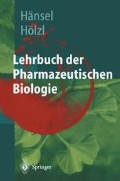Zusammenfassung
Unter dem Begriff Gentechnologie versteht man eine Sammlung von Methoden, mit deren Hilfe die als Erbmaterial fungierende Desoxyribonuldeinsäure (DNA) isoliert, charakterisiert und modifiziert werden kann. Die DNA liegt in der Zelle in Form von Chromosomen vor. Niedere Organismen wie Bakterien besitzen nur ein einziges Chromosom und damit nur ein einziges Molekül DNA; bei höheren Organismen ist das genetische Material auf mehrere Chromosomen verteilt. Die Gesamtheit aller Chromosomen bezeichnet man als Genom. Alle Genome in der belebten Natur sind aus den 4 Nukleotidbasen Adenin, Guanin, Cytosin und Thymin aufgebaut. Diese treten spezifisch und nach allgemein gültigen Regeln paarweise in Wechselwirkung, wobei immer ein Adenin mit einem Thymin und ein Guanin mit einem Cytosin komplementäre Nukleotidpaare bilden. Diese Regeln bilden die Basis sowohl für die identische Verdopplung der DNA vor jeder Zellteilung (= Replikation) als auch für das Abrufen der genetischen Information (= Transkription). Da alle RNA-Polymerasen statt Thymidintriphosphat (TTP) Uridintriphosphat (UTP) verwenden, enthalten RNAs immer statt eines Thymins ein Uracil. Der genetische Informationsfluß wird abgeschlossen durch das Um-schreiben der in der Boten-RNA zwischengespeicherten Information in Protein (= Translation). Auch dieser Vorgang basiert auf den typischen Wechselwirkungen zwischen Nukleinsäuren. Dabei lagern sich Transfer-RNAs, die mit spezifischen Aminosäuren beladen sind, mit ihren aus 3 Basen bestehenden Anticodons an komplementäre Codonsequenzen auf der mRNA an, wodurch Aminosäuren derart in Position zueinander gebracht werden, daß sie entsprechend der In-formation in der mRNA miteinander zu einem Protein verknüpft werden können.
Access this chapter
Tax calculation will be finalised at checkout
Purchases are for personal use only
Preview
Unable to display preview. Download preview PDF.
Literatur
Baltimore D (1970) RNA-dependent DNA polymerases in virions of RNA tumor viruses. Nature (London) 226:1209–1210
Capecchi MR (1980) High efficiency transformation by direct microinjection of DNA into cultured mammalian cells. Cell 22: 479–488
Crick FHC, Watson JD (1954) The complementary structure of deoxyribonucleic acid. Proc R Soc A 223:80–96
Dingermann T (1992) Vom Gewächshaus über den Fermenter in den Tierstall: Neue Wege in der Pharmazeutischen Biologie. Dtsch Apotheker Z 132:1216–1224
Hernalsteens JP, van Vliet F, De Benckeleer M, Depicker A, Engler G, Lemmers M, Holsters M, van Montagu M, Schell J (1980) The Agrobacterium tumefaciens Ti plasmid as a host vector system for introducing foreign DNA in plant cells. Nature (London) 287:654–656
Hohn B (1979) In vitro packaging of Lambda and Cosmid DNA. Meth Enzymol 68:299–309
Horwitz JP, Chua J, Curby RJ, Thomson AJ, Da Rooge MA, Fischer BE, Mauricio J, Klundt I (1964) Substrates for cytochemical demonstration of enzyme activity. I. Some substituted 3-indolyl-ß-D-glucopyranosides. J Med Chem 7:547–548
Knippers R, Philippsen P, Schäfer KP, Fanning E (1990) Molekulare Genetik. Thieme, Stuttgart
Lewin B (1988) Gene, 1. Aufl. VCH Weinheim
Mandel M, Higa A (1970) Calcium dependent bacteriophage DNA infection. J Mol Biol 53:154–162
Maxam AM, Gilbert W (1977) A new method for sequencing DNA. Proc Natl Acad Sci USA 74:560–564
Maxam AM, Gilbert W (1980) Sequencing end-labelled DNA with base-specific chemical cleavages. Meth Enzymol 65: 499–560
Neumann E, Schaefer-Ridder M, Wang Y, Hofschneider PH (1982) Gene transfer into mouse L-cells by electroporation in high electric fields. EMBO J 1:841–845
Sanger F, Nickler S, Coulson AR (1977) DNA sequencing with chain-terminating inhibitors. Proc Natl Acad Sci USA 74:5463–5467
Shen YM, Hirshhorn RR, Mercer WE, Surmacz E, Tsutsui Y, Soprano KJ, Baserga R (1982) Gene transfer: DNA microinjection compared with DNA transfection with a very high efficiency. Mol Cell Biol 2:1145–1154
Smith AJH (1980) DNA sequence analysis by primed synthesis. Meth Enzymol 65:560–580
Smith HO, Nathans D (1973) A suggested nomenclature for bacterial host modifications and restriction systems and their enzymes. J Mol Biol 81:419–423
Temin HM, Mizutani S (1970) RNA-dependant DNA polymerase in virions or Rous sarcoma virus. Nature (London) 226:1211–1213
Van Montagu M, Schell J (1982) The Ti plasmids of Agrobacterium. Curr Top Microbiol Immunol 96:237–254
Watson JD, Crick FHC (1953) Molecular structure of nucleic acids: a structure for deoxyribose nucleic adic. Nature (London) 171:964–967
Editor information
Editors and Affiliations
Rights and permissions
Copyright information
© 1996 Springer-Verlag Berlin Heidelberg
About this chapter
Cite this chapter
Dingermann, T. (1996). Gentechnologie. In: Hänsel, R., Hölzl, J. (eds) Lehrbuch der pharmazeutischen Biologie. Springer, Berlin, Heidelberg. https://doi.org/10.1007/978-3-642-60958-9_13
Download citation
DOI: https://doi.org/10.1007/978-3-642-60958-9_13
Publisher Name: Springer, Berlin, Heidelberg
Print ISBN: 978-3-642-64628-7
Online ISBN: 978-3-642-60958-9
eBook Packages: Springer Book Archive

